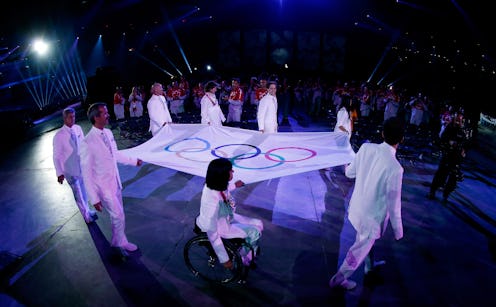News
This Olympic Flag Rule Is Pretty Interesting
The Olympic Games are filled with all types of rituals, many of which are borrowed from ancient days, when similar events were held in Greece. From the passing of the torch to the perpetual burning of the Olympic flame, plenty of what once built the games is still present today. But there is one ritual that doesn't find its origins in Olympia, Greece — and that is a specific rule regarding the Olympic flag. Olympic flag bearers must carry the emblem horizontally at all times, with no exceptions.
After the host country's head of state announces the opening of the games, the Olympic flag is carried out into the stadium and raised while the Olympic Hymn is played. Generally, the flag is carried by prominent athletes from the host country. There have been some deviations to this rule, however — Muhammad Ali served as a symbolic flag bearer in the 2012 Summer Games, and this year, a group of refugees will take center stage as they carry the flag for the Rio de Janeiro Olympics.
The tradition to hold the flag horizontally began during the 1960 Summer Games in Rome, Italy. Though there doesn't seem to be specific information on why this change occurred, there are some probable guesses.
The decision to hold the flag horizontally rather than vertically may pay homage to the Olympics' "dip rule," which asks countries to momentarily dip their flags when passing the box where the host nation's leaders are seated as a sign of respect. (Famously, America does not abide by this Olympic guideline).
The Olympic flag might be held horizontally for a similar reason: It's a sign of respect, so that it is kept lower than each of the countries' individual flags. The flag itself represents the unity of nations, so its lowered position may help reassert that collective bond.
There is another potential reason, which finds its origins in history. During battle, flags were decorated with horizontal patterns to make them easier to see when being raised. In this same vein, the Olympic flag may be carried out this way to simply make it easier for athletes and the audience to see it before it's hoisted.
Whatever the case may be, it's likely that this tradition will be longstanding. Paying respect to the Olympic flag, whether by the way it's carried or by being flown throughout the entire event, has always been significant for the games.
